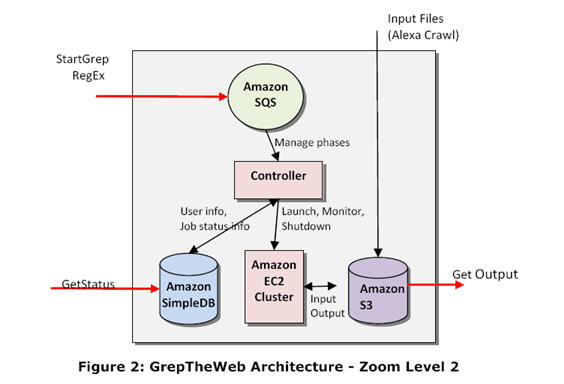AWS News Blog
White Paper on ‘Cloud Architectures’ and Best Practices of Amazon S3, EC2, SimpleDB, SQS
|
|
I am very happy to announce my white paper on Cloud Architectures is now ready. This is one incarnation of the Emerging Cloud Service Architectures that Jeff wrote about a few weeks ago.
If you are new to the cloud, the first section of the paper will help you understand the benefits of building applications in-the-cloud. If you are using the cloud already, the second section of the paper will help you to use the cloud more effectively by utilizing some of the best practices.
In this paper, I discuss a new way to design architectures. Cloud Architectures are Services-Oriented Architectures that are designed to use On-demand infrastructure more effectively. Applications built on Cloud Architectures are such that the underlying computing infrastructure is used only when it is needed (for example to process a user request), draw the necessary resources on-demand (like compute servers or storage), perform a specific job, then relinquish the unneeded resources after the job is done. While in operation the application scales up or down elastically based on actual need for resources. Everything is automated and operates without any human intervention.
As an example of a Cloud Architecture, I discuss the GrepTheWeb application. This application runs a regular expression against millions of documents from the web and returns the filtered results which match the query. The architecture is interesting because it is runs completely on-demand in automated fashion. Triggered by a regex request, hundreds of Amazon EC2 instances are launched, a Hadoop Cluster is started on them, transient messages are stored on Amazon SQS queues, statuses in Amazon SimpleDB, and all Map/Reduce jobs are run in parallel. Each Map task fetches the file from Amazon S3 and runs the regular expression – and aggregates all the results in the Reduce/Combine Phase and then disposes all the infrastructure back into the cloud (when the Hadoop job is processed)
GrepTheWeb is one of many applications built by Amazon that uses all our services (Amazon EC2, Amazon SimpleDB, Amazon SQS, Amazon S3) together.
A wide variety of different types of applications that can be built using this design approach – from nightly batch processing systems to media processing pipelines.
An excerpt:
Cloud Architectures address key difficulties surrounding large-scale data processing. In traditional data processing it is difficult to get as many machines as an application needs. Second, it is difficult to get the machines when one needs them. Third, it is difficult to distribute and co-ordinate a large-scale job on different machines, run processes on them, and provision another machine to recover if one machine fails. Fourth, it is difficult to auto-scale up and down based on dynamic workloads. Fifth, it is difficult to get rid of all those machines when the job is done. Cloud Architectures solve such difficulties.
Applications built on Cloud Architectures run in-the-cloud where the physical location of the infrastructure is determined by the provider. They take advantage of simple APIs of Internet-accessible services that scale on-demand, that are industrial-strength, where the complex reliability and scalability logic of the underlying services remains implemented and hidden inside-the-cloud. The usage of resources in Cloud Architectures is as needed, sometimes ephemeral or seasonal, thereby providing the highest utilization and optimum bang for the buck.
In the first section I discuss the advantages and business benefits of Cloud Architectures and how each service was used. In the second section, I discuss best practices for the various Amazon Web Services.
You can download the PDF version or access it on AWS Resource Center
- PDF Version – Cloud Architectures
- HTML Version
Building GrepTheWeb in the Cloud, Part 1: Cloud Architectures
Building GrepTheWeb in the Cloud, Part 2: Best Practices and Lessons Learned
I talked about this briefly at the Hadoop Summit 2008 and QCon 2007. I got some good reviews after the talk and hence I decided to put all my thoughts in this paper along with some Best Practices for the use of Amazon Web Services (Amazon EC2, Amazon SQS, Amazon S3 and Amazon SimpleDB together). Many developers from our community have been asking for a real-world example of a complex, large-scale application. I will presenting this paper at the 2008 NSF Data-Intensive Scalable Computing Workshop at UW and 9th IEEE/NATEA Conference on Cloud Computing later this week.
I believe this new and emerging way of building applications, that run in-the-cloud, is going to change the way we do business.
— Jinesh


